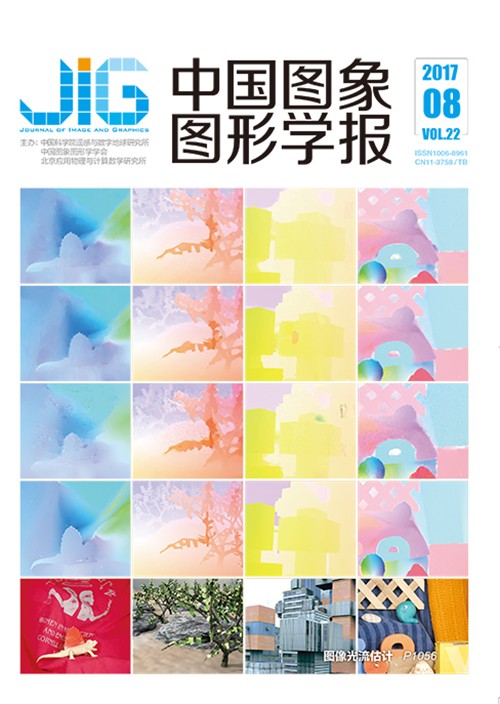
强边缘导向的盲去模糊算法
摘 要
目的 在图像的获取过程中,成像设备与拍摄场景发生了相对位移,导致获取的实际图像存在信息丢失、模糊退化的现象,这极大地影响了图像的质量和人们的视觉体验,也影响了图像的后续处理。盲去卷积旨在从观测图像中估计模糊核并获得清晰图像,为此提出了一种基于强边缘的运动图像盲去模糊算法。方法 结合图像梯度稀疏性,采用自适应l0范数约束待估计图像梯度的强边缘;针对模糊核稀疏性和连续性,以l0-l2范数分别约束模糊核的像素和梯度,同时把模糊核归一化先验作为正则项引入模型中,以强边缘指导模糊核估计。在去模糊阶段,结合全变分与超拉普拉斯正则化方法的优点,将两种方法复原的图像取平均,以减轻复原图像中的振铃效应,同时保留更多的图像细节。结果 为了检验本文算法的有效性,对Levin测试集和实际拍摄的模糊图像分别进行仿真,并同现有算法进行比较。Levin测试集上的实验结果表明,提出的盲反卷积成功率为100%且在对比算法中具有最高PSNR;实际彩色图像的盲反卷积实验表明,相比于其他算法,本文算法获得的模糊核具有更准确的支撑和较少的噪点,获得的清晰图像具有较优的视觉效果。结论 该方法从定量和定性比较上都体现了较好的去运动模糊能力,可适用于遥感、医学等领域。
关键词
Strong edge-oriented blind deblurring algorithm
Chen Huahua, Bao Zongpao(School of Communication Engineering, Hangzhou Dianzi University, Hangzhou 310018, China) Abstract
Objective In image acquisition, the relative displacement between the imaging device and shooting scene causes loss of information and blurring degradation, which significantly affects image quality and visual experience and results in various complicated processing on the images.Non-blind deconvolution obtains a sharp latent image from a blurred image with a known blur kernel.By contrast, blind deconvolution, which aims to estimate the unknown blur from the observed blurred image and recover a sharp original image, is challenging.Thus, blind deconvolution has been an active research area in image processing communities over the last four decades.Given the problem of image deblurring, most approaches introduce an image prior that favors natural images over degraded ones.This approach can achieve high-quality results.Thus, a blind deblurring approach based on strong edges is proposed in this study.Method The sparsity of image gradient is combined with the strong edges of the latent image gradient and then regularized by an adaptive l0-norm.The adaptive l0-norm is a weighted metric that measures the usefulness of gradients, the large metric corresponding to pixels in flat regions or rich-texture regions, and the small metric corresponding to pixels in strong-edged regions.For the sparsity and the continuity of the blur kernel, the pixels and the gradient of the blur kernel are regularized using the l0 and l2 norms, respectively.Meanwhile, the blur kernel is normalized in advanced and introduced into the optimization model as a regularized term, where strong edges are used to direct the blur kernel estimate.The prior sparse gradient image and the compound priors for sparsity of the gradient of the blur kernel, the continuity and the normalization of the blur kernel are considered;thus the proposed model favors sharp images over the degraded images.Obtaining an accurate solution using the proposed model is slightly complicated.Thus, an alternating iteration approach is performed to solve the model by updating the process iteration through two easy sub-problems, namely, latent image estimate and blur kernel estimate.An augmented Lagrangian method (ALM) is used to identify the latent image, and a quadratic function method is used to determine the blur kernel.For the latent image solution, the sub-problem is equivalently formulated as an unconstrained optimization problem by introducing an auxiliary variable w in the sub-model, which is performed using ALM.The solution is obtained by an alternating optimization strategy, such that w is updated by iteratively hard thresholding method, and latent image is updated by iteratively fast Fourier transform in the frequency domain.In the blur kernel process, the sub-problem is equivalently described as an unconstrained problem, with auxiliary variable g.To obtain the solution, the sub-problem is decomposed into two easy sub-problems with regard to g and the blur kernel and iterating each alternately, such that g is updated by the iteratively hard thresholding method, and the blur kernel is updated by the iteratively quadratic function optimization.Image deconvolution using a prior hyper-Laplacian can obtain a clear image with main structures and few artifacts but sometimes it fails to preserve some fine details.Moreover, total variation norm can preserve abundant small textures but retains noise and ringing artifacts.For the restored image estimation, the estimated blur kernel and the two algorithms are combined to utilize their merits, reduce their limitations, and build the corresponding optimization with respect to the intermediate with rich saliency edges which are the blurred observation enhanced by a shock filter, and the sharp image is then obtained by averaging the results recovered from the prior hyper-Laplacian-based method and the total variation norm-based method.Thus, the ringing effect in the restored image is reduced while preserving more image details.Result To test the effectiveness of the proposed algorithm, the Levin set and the actual blurred images are tested and compared with state-of-the-art algorithms.The ratio of deconvolution error (RDE) and peak signal-to-noise ratio (PSNR) are used to evaluate the results in the Levin set.Experiments on the Levin data set show that the proposed method achieves a successful rate of blind deconvolution (100%) even with the smallest RDE of less than 2.6.This result is higher than that of the second-best method (0.3) and much higher than that of the worst method (2.4).The largest PSNR is 30.59 dB, which is greater than those of the second-best approach (1.01 dB) and the worst approach (19.81 dB).The extensive details show that the blur kernel obtained from the proposed method has more accurate support, less noise, and achieves sharp images with better visual effects.Experiments on actual color images demonstrate the proposed method can obtain more accurate blur kernel and better image quality compared with the state-of-the-art algorithms.The proposed method provides a dominant recovery but is also time consuming compared with the state-of-the-art algorithms.Conclusion The proposed method outperforms the other algorithms and appears to be outstanding in latent image and blur kernel estimate and in image quantitative and qualitative motion deblurring.This method can be used in remote sensing, medicine, and other fields.Comparison of time consumption shows that better overall performance of the proposed method can be obtained by improving the algorithm optimization, as well as performing parallel implementation in the future.
Keywords
|



 中国图象图形学报 │ 京ICP备05080539号-4 │ 本系统由
中国图象图形学报 │ 京ICP备05080539号-4 │ 本系统由